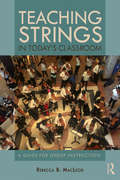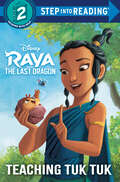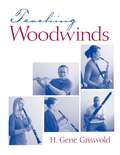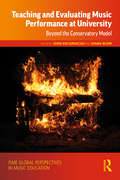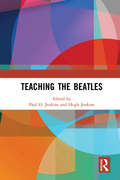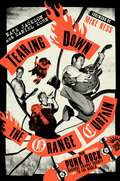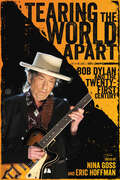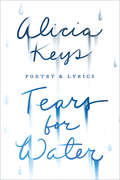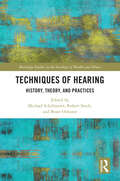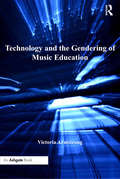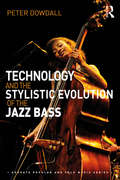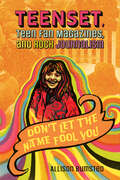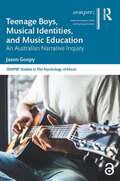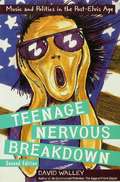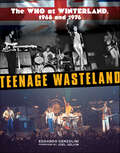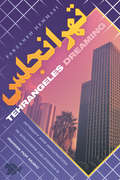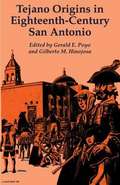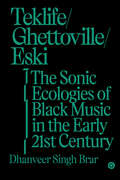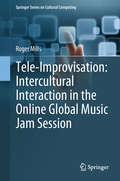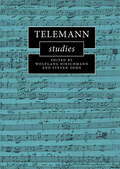- Table View
- List View
Teaching Strings in Today's Classroom: A Guide for Group Instruction
by Rebecca B. MacLeod<p>Teaching Strings in Today’s Classroom: A Guide for Group Instruction assists music education students, in-service teachers, and performers to realize their goals of becoming effective string educators. It introduces readers to the school orchestra environment, presents the foundational concepts needed to teach strings, and provides opportunities for the reader to apply this information. The author describes how becoming an effective string teacher requires three things of equal importance: content knowledge, performance skills, and opportunities to apply the content knowledge and performance skills in a teaching situation. <p>In two parts, the text addresses the unique context that is teaching strings, a practice with its own objectives and related teaching strategies. Part I (Foundations of Teaching and Learning String Instruments) first presents an overview of the string teaching environment, encouraging the reader to consider how context impacts teaching, followed by practical discussions of instrument sizing and position, chapters on the development of each hand, and instruction for best practices concerning tone production, articulation, and bowing guidelines. Part II (Understanding Fingerings) provides clear guidance for understanding basic finger patterns, positions, and the creation of logical fingerings. String fingerings are abstract and thus difficult to negotiate without years of playing experience—these chapters (and their corresponding interactive online tutorials) distill the content knowledge required to understand string fingerings in a way that non-string players can understand and use. <p>Teaching Strings in Today’s Classroom contains pedagogical information, performance activities, and an online virtual teaching environment with twelve interactive tutorials, three for each of the four string instruments.</p>
Teaching Tuk Tuk (Step into Reading)
by Mei NakamuraThis Step 2 Step into Reading leveled reader with more than 30 stickers is based on Disney's new animated film Raya and the Last Dragon!Discover how Raya and Tuk Tuk met and became friends in this Step 2 Step into Reading leveled reader! Children ages 4 to 6 will love this story based on the Disney animated film–with more than 30 stickers! Step 2 readers use basic vocabulary and short sentences to tell simple stories. For children who recognize familiar words and can sound out new words with help. Walt Disney Animation Studios' fantasy-action-adventure, Raya and the Last Dragon, introduces Raya, a lone warrior from the fantasy kingdom of Kumandra who teams up with a crew of misfits in her quest to find the last dragon and bring light and unity back to their world. Awkwafina lends her voice to Sisu, the last dragon, who was left on Kumandra in case dark forces return to the world, and Kelly Marie Tran voices the lead character, Raya. Exploring themes of community and hope, and inspired by the beautiful and diverse cultures of Southeast Asia, the fantasy-action-adventure Raya and the Last Dragon opened in U.S. theaters on March 12th 2021.
Teaching Violin, Viola, Cello, and Double Bass: Historical and Modern Pedagogical Practices
by Miranda Wilson Dijana Ihas Gaelen McCormickTeaching Violin, Viola, Cello, and Double Bass summarizes three centuries of string pedagogy treatises to create a comprehensive resource on methods and approaches to teaching all four bowed string instruments. Co-written by three performance and pedagogy experts, each specializing in different string instruments, this book is applicable to all levels of instruction. Essays on historical pedagogues are clearly structured to allow for easy comprehension of their philosophies, pedagogical practices, and unique contributions. This book concludes with a section on application through comparative analysis of the historical methods and approaches. With coverage from the eighteenth century to the present, this book will be invaluable for teachers and students of string pedagogy and general readers who wish to learn more about string pedagogy’s rich history, diverse content, and modern developments.
Teaching Violin, Viola, Cello, and Double Bass: Historical and Modern Pedagogical Practices
by Miranda Wilson Dijana Ihas Gaelen McCormickTeaching Violin, Viola, Cello, and Double Bass summarizes three centuries of string pedagogy treatises to create a comprehensive resource on methods and approaches to teaching all four bowed string instruments. Co-written by three performance and pedagogy experts, each specializing in different string instruments, this book is applicable to all levels of instruction.Essays on historical pedagogues are clearly structured to allow for easy comprehension of their philosophies, pedagogical practices, and unique contributions. This book concludes with a section on application through comparative analysis of the historical methods and approaches.With coverage from the eighteenth century to the present, this book will be invaluable for teachers and students of string pedagogy and general readers who wish to learn more about string pedagogy’s rich history, diverse content, and modern developments.
Teaching Woodwinds
by Harold Gene GriswoldFor one semester/quarter courses in woodwind methods. Teaching Woodwinds has draws on the authors thirty-five years of experience teaching woodwinds to students. Organized by specific teach topics from the fundamentals of hand and finger position to articulation and intonation. Drawing on a classic set of teacher/student duets, the included twenty-five class lessons enable students to learn by doing and by listening as they play duets with the instructor.
Teaching and Evaluating Music Performance at University: Beyond the Conservatory Model (ISME Global Perspectives in Music Education Series)
by John EncarnacaoFresh perspectives on teaching and evaluating music performance in higher education are offered in this book. One-to-one pedagogy and Western art music, once default positions of instrumental teaching, are giving way to a range of approaches that seek to engage with the challenges of the music industry and higher education sector funding models of the twenty-first century. Many of these approaches – formal, informal, semi-autonomous, notated, using improvisation or aleatory principles, incorporating new technology – are discussed here. Chapters also consider the evolution of the student, play as a medium for learning, reflective essay writing, multimodal performance, interactivity and assessment criteria. The contributors to this edited volume are lecturer-practitioners – choristers, instrumentalists, producers and technologists who ground their research in real-life situations. The perspectives extend to the challenges of professional development programs and in several chapters incorporate the experiences of students. Grounded in the latest music education research, the book surveys a contemporary landscape where all types of musical expression are valued; not just those of the conservatory model of decades past. This volume will provide ideas and spark debate for anyone teaching and evaluating music performance in higher education.
Teaching the Beatles
by Paul O. Jenkins and Hugh JenkinsTeaching the Beatles is designed to provide ideas for instructors who teach the music of the Beatles. Experienced contributors describe varied approaches to effectively convey the group’s characteristics and lasting importance. Some of these include: treating the Beatles’ lyrics as poetry; their influence on the world of art, film, fashion and spirituality; the group’s impact on post-war Britain; political aspects of the Fab Four; Lennon and McCartney’s songwriting and musical innovations; the band’s use of recording technology; business aspects of the Beatles’ career; and insights into teaching the Beatles in an online format.
Team Piano Repertoire: A Manual of Music for Multiple Players at One or More Pianos
by Frederic Ming Chang Albert FaurotListing of classical musical pieces written for 2 or more piano players
Tearing Down the Orange Curtain: How Punk Rock Brought Orange County to the World
by Nate Jackson Daniel KohnThe untold story of OC punk—the loud, rebellious force behind the &‘90s explosion of the Orange County music scene, featuring stories about legendary bands. When it comes to punk communities across the world, the Orange County punk scene stands out as an undeniable trendsetter that helped define the sound and style of the rapidly evolving genre. From hard luck storytellers Social Distortion and multi-platinum sellers like The Offspring to cult heroes like The Adolescents and T.S.O.L., there&’s much insight to gain from the story of this popular though often misunderstood music scene. In Tearing Down the Orange Curtain, journalists Nate Jackson and Daniel Kohn explore the trajectory of punk and ska from their humble beginnings to their peak popularity years, where their cultural impact could be felt in music around the world. Delving deep into the personal and professional lives of bands like Social Distortion, The Adolescents, The Offspring, and their ska counterparts No Doubt, Sublime, Reel Big Fish, Save Ferris, and more, this book gives readers a deeper look into the very human stories of these musicians, many of whom struggled with acceptance, addiction, and brutal teenage years in suburbia. Through exclusive first-hand interviews, Tearing Down the Orange Curtain brings the 20-year period of OC punk and third-wave ska (1978-2000) to life, focusing specifically on the historical and musical roots of this creative explosion. Thought-provoking, meticulously researched, and refreshingly candid, this book presents a compelling narrative of how a suburban wasteland turned into a hub for rock-n roll culture, just over 30 miles away from the bright lights of LA.
Tearing the World Apart: Bob Dylan and the Twenty-First Century (American Made Music Series)
by Nina Goss and Eric HoffmanContributions by Alberto Brodesco, James Cody, Andrea Cossu, Anne Margaret Daniel, Jesper Doolard, Nina Goss, Jonathan Hodgers, Jamie Lorentzen, Fahri Öz, Nick Smart, and Thad Williamson Bob Dylan is many things to many people. Folk prodigy. Rock poet. Quiet gentleman. Dionysian impresario. Cotton Mather. Stage hog. Each of these Dylan creations comes with its own accessories, including a costume, a hairstyle, a voice, a lyrical register, a metaphysics, an audience, and a library of commentary. Each Bob Dylan joins a collective cast that has made up his persona for over fifty years. No version of Dylan turns out uncomplicated, but the postmillennial manifestation seems peculiarly contrary—a tireless and enterprising antiquarian; a creator of singular texts and sounds through promiscuous poaching; an artist of innovation and uncanny renewal. This is a Dylan of persistent surrender from and engagement with a world he perceives as broken and enduring, addressing us from a past that is lost and yet forever present. Tearing the World Apart participates in the creation of the postmillennial Bob Dylan by exploring three central records of the twenty-first century—“Love and Theft” (2001), Modern Times (2006), and Tempest (2012)—along with the 2003 film Masked and Anonymous, which Dylan helped write and in which he appears as an actor and musical performer. The collection of essays does justice to this difficult Bob Dylan by examining his method and effects through a disparate set of viewpoints. Readers will find a variety of critical contexts and cultural perspectives as well as a range of experiences as members of Dylan's audience. The essays in Tearing the World Apart illuminate, as a prism might, their intransigent subject from enticing and intersecting angles.
Tears for Water: Poetry & Lyrics
by Alicia KeysFrom acclaimed musician Alicia Keys comes a revealing songbook of collected poems and lyrics that document her growth as a person, a woman, and an artist.&“All my life, I&’ve written these words with no thought or intention of sharing them. Not even with my confidants. These are my most delicate thoughts. The ones that I wrote down just so I could understand what in the world these things I was thinking meant...&” When she burst onto the music scene with her multi-million bestselling, Grammy® Award-winning first album, Songs in A Minor, Alicia Keys became a superstar. Two decades later, her career has expanded into producing, acting, and passionate activism—winning her worldwide acclaim, numerous awards, and a spot on Time&’s list of &“The 100 Most Influential People.&”Though Alicia has been very vocal through her career, there were always &“delicate thoughts&” that she never before imagined she&’d share with anyone else—until now. In Tears for Water, Alicia Keys opens the journals and notebooks that she has kept throughout her life and reveals her heart to her fans in return for all the love they have shown to her and her music.Hello morningnow I see youcause I am awakeWhat was once so sweet and securehas turned out to be fakeGirl, you can&’t be scaredgotta stand up tall and let &’em see what shines in youPush aside the partlying in your heartlike the ocean is deep, dark and blue—from Golden Child
Techniques of Hearing: History, Theory and Practices
by Michael Schillmeier, Robert Stock, and Beate OchsnerHearing, health and technologies are entangled in multi-faceted ways. The edited volume addresses this complex relationship by arguing that modern hearing was and is increasingly linked to and mediated by technological innovations. By providing a set of original interdisciplinary investigations that sheds new light on the history, theory and practices of hearing techniques, it is able to explore the heterogeneous entanglements of sound, hearing practices, technologies and health issues. As the first book to bring together historians, scholars from media studies, social sciences, cultural studies, acoustics and neuroscientists, the volume discusses modern technologies and their decisive impact on how ‘normal’ hearing, enhanced and smart hearing as well as hearing impairment have been configured. It brings both new insights into the histories of hearing technologies as well as allowing us to better understand how enabling hearing technologies have currently been unfolding an increasingly hybrid ecology engaging smart hearing devices and offering stress-free hearing and acoustic wellbeing in novel auditory environments. The volume will be of interest to all scholars and students of disability studies, sound studies, sociology of health and illness, medical history, health and society as well as those interested in the practices and techniques of self-monitored and smart hearing.
Techno Rebels: The Renegades of Electronic Funk
by Bill Brewster Dan SickoAn updated, expanded history of techno music with special attention to its roots in Detroit.
Technology and the Gendering of Music Education
by Victoria ArmstrongCritical of technologically determinist assumptions underpinning current educational policy, Victoria Armstrong argues that this growing technicism has grave implications for the music classroom where composition is often synonymous with the music technology suite. The use of computers and associated compositional software in music education is frequently decontextualized from cultural and social relationships, thereby ignoring the fact that new technologies are used and developed within existing social spaces that are always already delineated along gender lines. Armstrong suggests these gender-technology relations have a profound effect on the ways adolescents compose music as well as how gendered identities in the technologized music classroom are constructed. Drawing together perspectives from the sociology of science and technology studies (STS) and the sociology of music, Armstrong examines the gendered processes and practices that contribute to how students learn about technology, the repertoire of teacher and student talk, its effect on student confidence and the issue of male control of technological knowledge. Even though girls and female teachers have technological knowledge and skill, the continuing material and symbolic associations of technology with men and masculinity contribute to the perception of women as less able and less interested in all things technological. In light of the fact that music technology is now central to many music-making practices across all sectors of education from primary, secondary through to higher education, this book provides a timely critical analysis that powerfully demonstrates why the relationship between gender and music technology should remain an important empirical consideration.
Technology and the Stylistic Evolution of the Jazz Bass (Ashgate Popular and Folk Music Series)
by Peter DowdallTechnology and the Stylistic Evolution of the Jazz Bass traces the stylistic evolution of jazz from the bass player’s perspective. Historical works to date have tended to pursue a ‘top down’ reading, one that emphasizes the influence of the treble instruments on the melodic and harmonic trajectory of jazz. This book augments that reading by examining the music’s development from the bottom up. It re-contextualizes the bass and its role in the evolution of jazz (and by extension popular music in general) by situating it alongside emerging music technologies. The bass and its technological mediation are shown to have driven changes in jazz language and musical style, and even transformed creative hierarchies in ways that have been largely overlooked. The book’s narrative is also informed by investigations into more commercial musical styles such as blues and rock, in order to assess how, and the degree to which, technological advances first deployed in these areas gradually became incorporated into general jazz praxis. Technology and the Jazz Bass reconciles technology more thoroughly into jazz historiography by detailing and evaluating those that are intrinsic to the instrument (including its eventual electrification) and those extrinsic to it (most notably evolving recording and digital technologies). The author illustrates how the implementation of these technologies has transformed the role of the bass in jazz, and with that, jazz music as an art form.
Teclados: Pasado y presente (¡Arriba la Lectura! Level V #63)
by Diana NoonanNIMAC-sourced textbook
TeenSet, Teen Fan Magazines, and Rock Journalism: Don't Let the Name Fool You
by Allison BumstedSince the magazine’s first issue in 1964, TeenSet’s role in popular music journalism has been overlooked and underappreciated. Teen fan magazines, often written by women and assumed to be read only by young girls, have been misconstrued by scholars and journalists to lack “seriousness” in their coverage of popular music. TeenSet, Teen Fan Magazines, and Rock Journalism: Don’t Let the Name Fool You disputes the prevailing conception that teen fan magazines are insignificant and elevates the publications to their proper place in popular music history. Analyzing TeenSet across its five-year publication span, Allison Bumsted shows that the magazine is an important artifact of 1960s American popular culture. Through its critical commentary and iconic rock photography, TeenSet engaged not only with musical genres and scenes, but also broader social issues such as politics, race, and gender. These countercultural discourses have been widely overlooked due to a generalization of teen fan magazines, which have wrongly presumed the magazine to be antithetical to rock music and as unimportant to broader American culture at the time. Bumsted also examines the leadership of editor Judith Sims and female TeenSet staff writers such as Carol Gold. By offering a counternarrative to leading male-oriented narratives in music journalism, she challenges current discourses that have marginalized women in popular music history. Ultimately, the book illustrates that TeenSet and teen fan magazines were meaningful not only to readers, but also to the broader development of the popular music press and 1960s cultural commentary.
Teenage Boys, Musical Identities, and Music Education: An Australian Narrative Inquiry (ISSN)
by Jason GoopyMusic is a powerful process and resource that can shape and support who we are and wish to be. The interaction between musical identities and learning music highlights school music education’s potential contributions and responsibilities, especially in supporting young people’s mental health and well-being. Through the distinctive stories and drawings of Aaron, Blake, Conor, Elijah, Michael, and Tyler, this book reveals the musical identities of teenage boys in their final year of study at an Australian boys’ school.This text serves as an interface between music, education, and psychology using narrative inquiry. Previous research in music education often seeks to generalise boys, whereas this study recognises and celebrates the diverse individual voices of students where music plays a significant role in their lives. Adolescent boys’ musical identities are examined using the theories of identity work and possible selves, and their underlying music values and uses are considered important guiding principles and motivating goals in their identity construction. A teaching and learning framework to shape and support multiple musical identities in senior secondary class music is presented.The relatable and personal stories in this book will appeal to a broad readership, including music teachers, teacher educators, researchers, and readers interested in the role of music in our lives. Creative and arts-based research methods, including narrative inquiry and innovative draw and tell interviews, will be particularly relevant for research method courses and postgraduate research students.
Teenage Nervous Breakdown: Music And Politics In The Post-elvis Age
by David WalleyTeenage Nervous Breakdown: Music and Politics in the Post-Elvis Era combines music and cultural history and criticism to examine how rock and the rock lifestyle have been merchandised first to a teenage audience and eventually to a worldwide consumer society. Well-known, iconoclastic writer/ critic David Walley examines the entire rock culture and
Teenage Wasteland: The Who at Winterland, 1968 and 1976
by Edoardo GenzoliniThe reason I am writing this book is because it has never been properly given credit to the real cradle of the Who&’s success: San Francisco. The concerts the Who played at promoter Bill Graham&’s Bay Area venues made them grow exponentially and unified them as a band at a time that guitarist Pete Townshend recalled as artistically and financially draining. San Francisco held the band together, gave it confidence and the right input that made it become what it is known for today. The two Winterland concerts in 1968 and 1976 are pivotal, in that 1968 is the one in which the most interesting experimentation took place, while the 1976 performance is considered the band&’s Zenit by everyone that was there.
Tehrangeles Dreaming: Intimacy and Imagination in Southern California's Iranian Pop Music
by Farzaneh HemmasiLos Angeles, called Tehrangeles because it is home to the largest concentration of Iranians outside of Iran, is the birthplace of a distinctive form of postrevolutionary pop music. Created by professional musicians and media producers fleeing Iran's revolutionary-era ban on “immoral” popular music, Tehrangeles pop has been a part of daily life for Iranians at home and abroad for decades. In Tehrangeles Dreaming Farzaneh Hemmasi draws on ethnographic fieldwork in Los Angeles and musical and textual analysis to examine how the songs, music videos, and television made in Tehrangeles express modes of Iranianness not possible in Iran. Exploring Tehrangeles pop producers' complex commercial and political positioning and the histories, sensations, and fantasies their music makes available to global Iranian audiences, Hemmasi shows how unquestionably Iranian forms of Tehrangeles popular culture exemplify the manner in which culture, media, and diaspora combine to respond to the Iranian state and its political transformations. The transnational circulation of Tehrangeles culture, she contends, transgresses Iran's geographical, legal, and moral boundaries while allowing all Iranians the ability to imagine new forms of identity and belonging.
Tejano Origins in Eighteenth-Century San Antonio
by Gerald E. Poyo Gilberto M. HinojosaSince its first publication in 1991, this history of early San Antonio has won a 1992 Citation from the San Antonio Conservation Society and a Presidio La Bahía Award from the Sons of the Republic of Texas.
Teklife, Ghettoville, Eski: The Sonic Ecologies of Black Music in the Early 21st Century (Goldsmiths Press / Sonics Series)
by Dhanveer Singh BrarHow black electronic dance music makes it possible to reorganize life within the contemporary city.Teklife, Ghettoville, Eski argues that Black electronic dance music produces sonic ecologies of Blackness that expose and reorder the contemporary racialization of the urban--ecologies that can never simply be reduced to their geographical and racial context. Dhanveer Singh Brar makes the case for Black electronic dance music as the cutting-edge aesthetic project of the diaspora, which due to the music's class character makes it possible to reorganize life within the contemporary city.Closely analysing the Footwork scene in South and West Chicago, the Grime scene in East London, and the output of the South London producer Actress, Brar pays attention to the way each of these critically acclaimed musical projects experiment with aesthetic form through an experimentation of the social. Through explicitly theoretical means, Teklife, Ghettoville, Eski foregrounds the sonic specificity of 12" records, EPs, albums, radio broadcasts, and recorded performances to make the case that Footwork, Grime, and Actress dissolve racialized spatial constraints that are thought to surround Black social life.Pushing the critical debates concerning the phonic materiality of blackness, undercommons, and aesthetic sociality in new directions, Teklife, Ghettoville, Eski rethinks these concepts through concrete examples of contemporary black electronic dance music production that allows for a theorization of the way Footwork, Grime, and Actress have--through their experiments in blackness--generated genuine alternatives to the functioning of the city under financialized racial capitalism.
Tele-Improvisation: Intercultural Interaction in the Online Global Music Jam Session (Springer Series on Cultural Computing)
by Roger MillsThis research monograph explores the rapidly expanding field of networked music making and the ways in which musicians of different cultures improvise together online. It draws on extensive research to uncover the creative and cognitive approaches that geographically dispersed musicians develop to interact in displaced tele-improvisatory collaboration. It presents a multimodal analysis of three tele-improvisatory performances that examine how cross-cultural musician’s express and perceive intentionality in these interactions, as well as their experiences of distributed agency and tele-presence.Tele-Improvisation: Intercultural Interaction in the Online Global Music Jam Session will provide essential reading for musician’s, postgraduate students, researchers and educators, working in the areas of telematic performance, musicology, music cognition, intercultural communication, distance collaboration and learning, digital humanities, Computer Supported Cooperative Work and HCI.
Telemann Studies (Cambridge Composer Studies)
by Wolfgang Hirschmann Steven ZohnEven as Georg Philipp Telemann's significance within eighteenth-century musical culture has become more widely appreciated in recent years, the English-language literature on his life and music has remained limited. This volume, bringing together sixteen essays by leading scholars from the USA, Germany, and Japan, helps to redress this imbalance as it signals a more international engagement with Telemann's legacy. The composer appears here not only as an important early Enlightenment figure, but also as a postmodern one. Chapters on his sacred music address the works' sensitivity to Lutheran and physico-theology, contrasting of historical and modern consciousness, and embodiment of an emerging opus concept. His secular compositions and writings are brought into rich dialogue with French musical and aesthetic currents. Also considered are Telemann's relationships with contemporaries such as Johann Sebastian Bach, the urban and courtly contexts for his music, and his influential position as 'general Kapellmeister' of protestant Germany.
